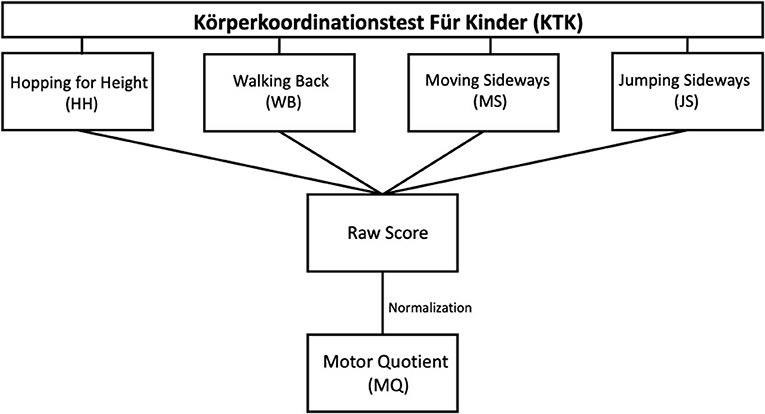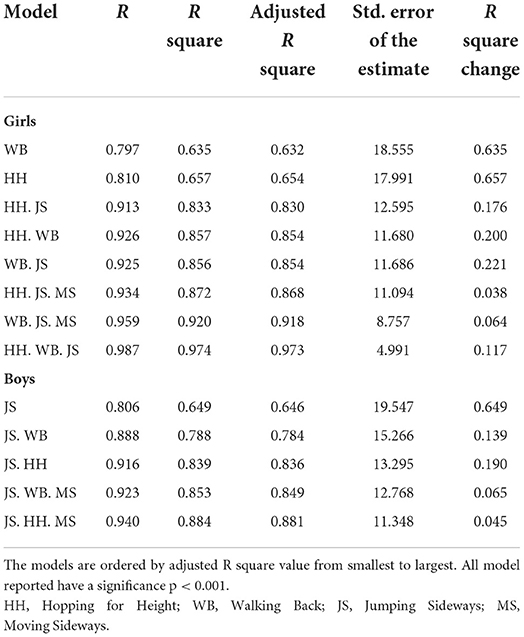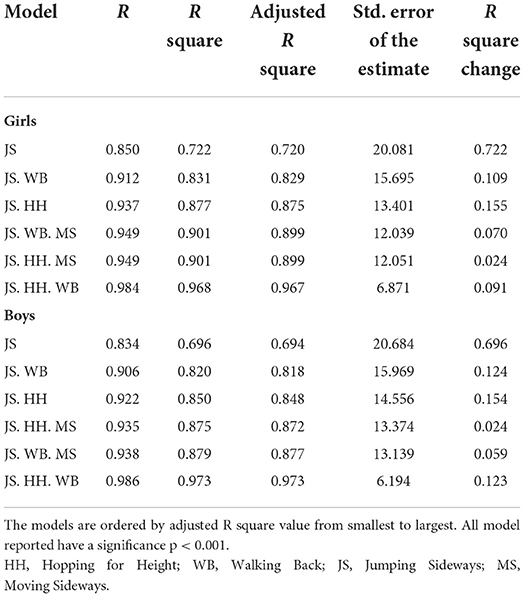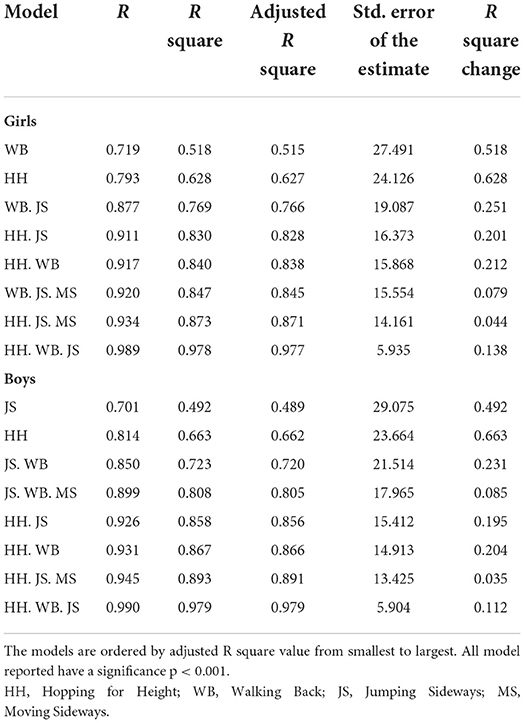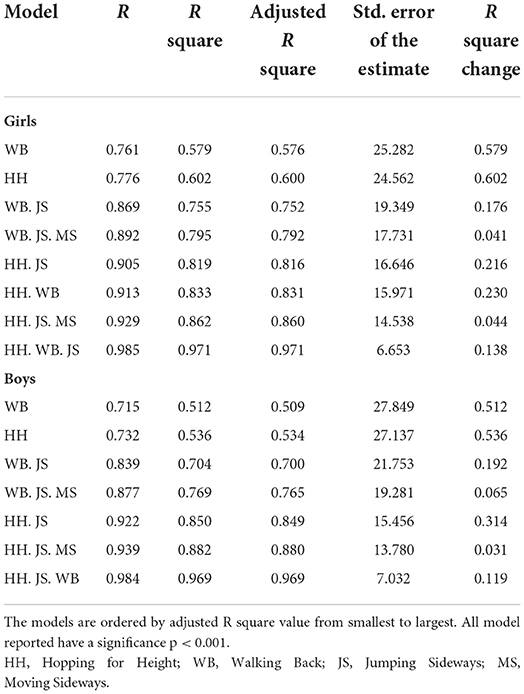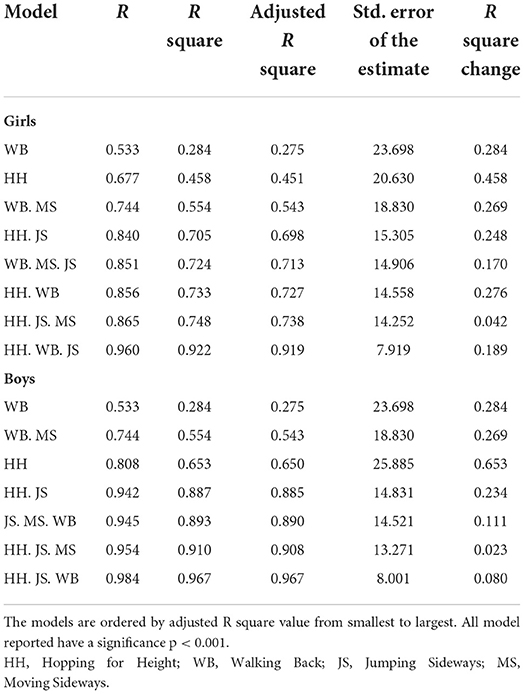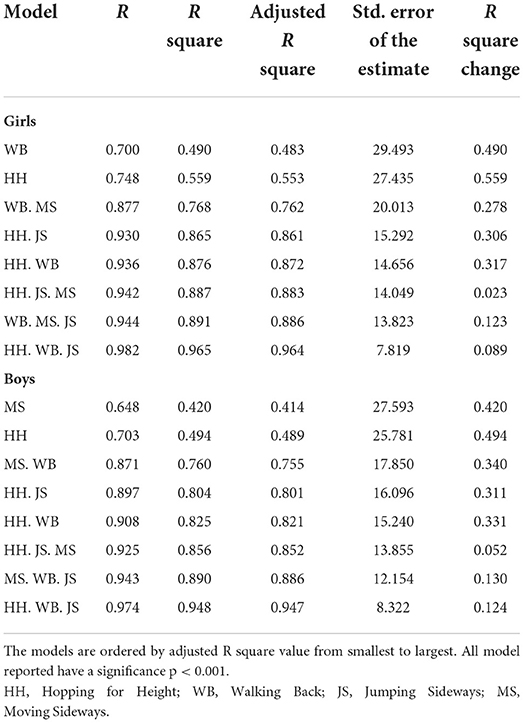Körperkoordinations test für Kinder: A short form is not fully satisfactory
- 1Department of Neurosciences, Biomedicine and Movement Sciences, University of Verona, Verona, Italy
- 2Sport and Exercise Sciences Research Unit, Department of Psychology, Educational Science and Human Movement, University of Palermo, Palermo, Italy
- 3Department of Unicusano, University Niccolò Cusano, Rome, Italy
- 4Department of Physiology and Pharmacology “Vittorio Erspamer”, Sapienza University of Rome, Rome, Italy
- 5Department of Theoretical and Applied Sciences, eCampus University, Novedrate, Italy
Assessment of motor competence (MC) is crucial to finding deficiencies in children's motor development. Because of the need to ensure validity, reliability, and feasibility, the selection of contemporary testing batteries is a difficult task. Many papers report the validity of the KTK test in describing MC in school aged children. KTK consists of 4 four separate items: walking back, jumping sideways, moving sideways, and hopping for height. Some authors suggested the use of a short version of KTK that includes 3 items excluding one subtest: hopping for height. This study aimed to evaluate the effectiveness of short versions of Körperkoordinationstest für Kinder (KTK). A sample of 2,231 participants (boys: n=1,188; girls: n = 1,043; age range: 6–12 years) were recruited from Italian schools between January 2019 and February 2020 and they performed the complete version of KTK. Stepwise linear regression was performed on the dataset to evaluate the ideal number of variables to describe the KTK short form version. Data for both the sexes and all ages indicated that considering the item combinations of each short version, the highest R squares were obtained in those that included exactly the deleted subtest (ranging from 0.881–0.979). The adoption of a short form does not seem to provide a fully satisfactory condition for measuring MC in children 6–12 years.
Introduction
Identifying motor competence (MC) during childhood is crucial, not only to finding excellence in sports or future talents (O'Brien-Smith et al., 2019) but also to assessing an appropriate coordination level (Giuriato et al., 2021). Indeed, an adequate MC allows for the functioning of daily motor skills (Barnett et al., 2022) and the achievement of physical fitness (Lopes et al., 2018; Stodden et al., 2019). MC is generally evaluated to define children at risk of developing poor-motor coordination, which may result in an inability to perform daily activities and participate in health-related physical activity or organized sport. MC is based on the components of physical fitness and motor coordination such as locomotion, manipulation, and stability (Gallahue et al., 2012; Barnett et al., 2016), which represent the primary focus for the development of motor skills.
Measuring pupils' level of MC performance provides an assessment of motor development. There are several test batteries to assess MC in children of all ages. A systematic review by Griffiths et al. (2018) outlines the majority of tools used to assess motor skills, including: the Bayley Scale of Infant and Toddler Development III (Bayley-III) (Urlich, 2019; Duncan et al., 2021), age range from 1 month to 3 years of age (Viezel et al., 2014); Test of Motor Proficiency (BOT-2), age range 4–21 years (Beitel and Mead, 1980); Movement Assessment Battery for Children (MABC-2), age range 3–16 years (Henderson and Sugden, 1992; Henderson et al., 2007); McCarron Assessment of Neuromuscular Development (MAND), 3–25 years (McCarron, 1997); Neurological Sensory Motor Developmental Assessment (NSMDA), from 1 month to 6 years (Burns et al., 1989); and Peabody Developmental Motor Scales second edition (PDMS-2), birth to 5 years (Folio and Fewell, 2000). All these test batteries provide an evaluation of fine and gross motor development and include balance, locomotion, object control, and an estimate of muscle strength (Barnett et al., 2016, 2022; Nascimento et al., 2019). Brian et al. (2016) investigated MC using test batteries that were converted to a standardized Motor Quotient (MQ) based on normative data: the Motor-Proficiency-Test for children (MOT 4-6) was validated with 548 children aged 4–6 years (Zimmer and Volkamer, 1987) and the Körperkoordination test für Kinder (KTK) was normalized on data of 1,128 German children aged 5–14 years (Kiphard and Schilling, 1974, 2007), both incorporated evaluation of fine and/or gross motor coordination skills.
Batteries such as the KTK have become widely used to measure general MC in young athletes (12 articles 2010–2014, 21 post-2015 in PubMed) (O'Brien-Smith et al., 2019), in addition, more than 50 articles about the assessment of gross motor coordination with the KTK test have been written from 2015 to date. The KTK assesses GMC through four subtests, i.e., walking backward (WB), jumping sideways (JS), moving sideways (MS), and hopping for height (HH) (Kiphard and Schilling, 1974, 2007). Its reliability and validity are well established (r = 0.97; WB = 0.80, JS = 0.95, MS = 0.85, and HH = 0.96).
Many studies (Fransen et al., 2014; Brian et al., 2016; Rudd et al., 2016; Ré et al., 2018) have focused on the validity and reliability of some test batteries such as BOT- 2 short forms vs. KTK, MOT 4–6 y vs. KTK, or TGMD-2 vs. KTK, showing their consistency. Although such consistency between these test batteries was moderate to adequate, these researchers recommended the scientific community not to evaluate children's MC based on the result of a single subtest, or a single test tool, but to consider a wider range of tests. This advice highlights that motor assessment is a complex issue, although these MC test batteries have excellent values of validity and reliability (Vandorpe et al., 2011; Griffiths et al., 2018). In addition, many researchers have raised the question of the feasibility of the test batteries, particularly, whether the performance measure is straightforward and easy to set up and administer. In terms of feasibility, the duration of the test and the potential risk of carrying out the tests are of significant importance. To reduce the duration, which often depends on the experience of the administrator and the age of the children, many authors have made short forms of their tests such as the BOT-2, or the TGMD-3 (Urlich, 2019).
Another reason for the proposal of short forms of some test batteries is the injury risk while performing the test (Novak et al., 2017). Therefore, some authors have shifted their attention to the short version of KTK (KTK 3) (Novak et al., 2017; O'Brien-Smith et al., 2019). The reason that led to the reduction of KTK to KTK 3, excluding the HH subtest is related to different causes, that is, the execution time which for KTK 3 is about 10 min instead of 20 min of the original KTK 4 version, and the reduced possibility of injury risk. KTK 3 is a reliable testing battery crosstab that revealed substantial agreement between the classification using KTK 3 and KTK 4 over all the age groups (Novak et al., 2017) and has therefore been used to assess MC across numerous individual and team sports such as soccer (Vandendriessche et al., 2012; Deprez et al., 2015), volleyball (Pion et al., 2015), and figure skating (Mostaert et al., 2016).
Moreover, the subtest of the monopodalic jump requires a large component of explosive force to gradually overcome greater heights, given by the addition of a 5 cm high cushion after each jump is performed correctly. A task strongly correlated with age and maturation is overcoming a single leg jump performed with both the right and the left leg of ~60 cm total height. In this task, by the age of 8–9 years, men tend to perform better than women in all the subtests of the KTK except for the monopodalic jumping test (Luz et al., 2016). The difference in the performance of this task may be due to the peak of growth, which is reached on average about 2 years earlier by girls compared to boys. Therefore, HH does not exclusively measure gross motor coordination, such as walking backward, moving sideways, or jumping sideways (which is a simple coordination task becoming difficult under time pressure, the 15 s of the KTK execution). This is also one reason why it has been removed by many researchers. Therefore, HH has been removed in the short version because it relies more on strength or explosivity, while the focus in the short version is more on pure coordination, i.e., how well a child can organize their body movements for a given task, regardless of how tall/strong they are.
Based on this evidence, some researchers have used only a subset of the test batteries found in the literature (Fransen et al., 2014; van der Fels et al., 2015; Valentini et al., 2018; Coppens et al., 2021). Coppens et al. (2021) to assesses MC in children and adolescents and added to KTK 3 an alternating one-handed throwing and catching task of a tennis ball, validating the KTK 3 “plus.” This version replaces the single leg jump with a task of throwing and catching a tennis ball against the wall (Platvoet et al., 2018). This recent review of the KTK test is also aimed at selecting the subtests of the KTK for tasks that are not conditioned by differences in body shape. BMI has been negatively associated with gross motor coordination (Battaglia et al., 2021) and does not seem to negatively affect the control abilities of the object (Barnett et al., 2016). Numerous studies (Fransen et al., 2014; Deprez et al., 2015; Pion et al., 2015) described significant differences in MS scores between high and low levels in athletes of both genders. It appears that this novel task can adequately represent gross motor coordination in children (O'Brien-Smith et al., 2019). The exercise consists of two valid tests of moving the tablets sideways over a period of 20 s as many times as possible.
Concerning the issue of the usefulness of test batteries, scientific literature agrees that MC is a complex and articulated question and that MC assessment should be approached carefully. Therefore, opting for a quick form of evaluation might not be consistent. It is uncertain whether shorter forms have a real advantage or if it is practical, in either case, this reduction removes information on the children's motor coordination.
This study aimed to identify whether there may be a short form or an extra-short form of the KTK that could be used to evaluate gross motor coordination in a sample of Italian children aged 6–12 years old, exploring whether shortcuts can assess MC. Analysis of the literature led us to hypothesize that the short form version of the KTK did not reduce information on MC levels.
Materials and methods
Participants
The present study is a part of research conducted between January 2019 and February 2020, in which 2,231 participants (boys: n = 1,188; girls: n = 1,043; age range: 6–12 years) were enrolled in primary and middle schools of northern, central, and southern Italy to assess motor coordination among a representative sample of the Italian children and early adolescents. Children with certification of movement disorders were excluded from the study. Table 1 shows the characteristics of the sample.
The authors received written informed consent from all the parents to participate in the study. To ensure participants' confidentiality, all the data were used anonymously. The study, in compliance with the Declaration of Helsinki, was approved by the Ethical Board of Verona University (N. 2019-UNVRCLE-0298910).
Anthropometric measurements
Anthropometric measurements (Table 1) were carried out using an electronic scale and a standard stadiometer to the nearest 0.5 kg and 0.1 cm to assess the participants' body mass (kg) and height (m) (Cole et al., 2000).
Motor coordination assessment
Motor competence was assessed with the Körperkoordinations test für Kinder (KTK) (Kiphard and Schilling, 1974, 2007), a test standardized for children aged 5 to 14 in which MC is expressed using the MQ index, a norm-referenced measure for age and gender. The KTK data were collected by the examiners trained in administering the test protocol and scored according to the manual guidelines.
The test protocol included the following four subtests: (1) walking backward (WB) on a balance beam of 3 m in the length of decreasing widths (6 cm, 4.5 cm, 3 cm); (2) two-legged jumping sideways (JS) from side-to-side over a beam (60 cm × 4 cm × 2 cm) as fast as possible for 15 s; (3) one-legged hopping for height (HH) over a foam obstacle of increasing height (consecutive increments of 5 cm); (4) moving sideways (MS) on the floor in 20 s by stepping from one plate (25 cm × 25 cm × 2 cm, supported on four legs 3.7 cm high) to the next, moving onto the first plate, stepping on it, and so on (Figure 1).
According to the manual, the MQ was computed by adding the four raw scores of each item and then standardized for age and gender.
Kiphard and Schilling (2007) reported that the KTK showed acceptable construct validity, indeed, the test–retest for the raw score on the test protocol detected a reliability coefficient of 0.97, and for each item, reliability coefficients ranged from 0.80 to 0.96 (Kiphard and Schilling, 1974, 2007).
Statistical analysis
All data were manually entered into a spreadsheet and checked for transcription errors, with corrections made where appropriate analyzing data with a linear model to exclude them. The dataset was also suspended for outliers. Stepwise linear regression was performed on the dataset to evaluate the ideal number of variables to describe the KTK test, short-form version: MQ as a dependent variable, and different items (HH, MS, JS, WB) as independent variables. All analyses were performed in SPSS Statistics (v21, IBM, Chicago, IL, USA). P-value of <0.05 was fixed. The reliability of the regression models was expressed with adjusted R Square (R2) and standard error of estimate (SEE).
Results
Stepwise linear regression was conducted to evaluate which subtest significantly predicted the model that described the KTK test. Adjusted R2 and SEE for both the sexes were summarized in Tables 2–8, respectively, for 6–12 years, and in Figure 2 only for three subtest versions. The model that better describes KTK with the highest R2 (0.979) and the lowest SEE (7.176) was composed of three items (WB, HH, and JS), accounting whole sample (all the ages) for both sex (p < 0.001). Accounting, only for girls HH, JS, and WB were the best significant model (p < 0.001) with high R2 (0.980) and the lowest SEE (6.966); further for boys with it was composed of HH, JS, and WB (R2 = 0.978; SEE = 7.365; p < 0.001).
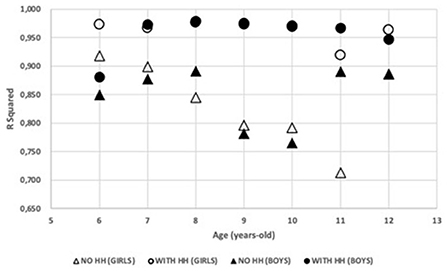
Figure 2. Comparison of short form's R squared. All the short forms that appear are composed of three items with HH (circle) and without HH (triangle), per sex (boys, full; girls, empty). NO HH, it is considering three items KTK with the highest R squared without HH; WITH HH, it is considering three items KTK with the highest R squared with HH. HH, Hopping Height item.
Furthermore, reducing two items the model with the highest R2 (0.900) and the lowest SEE (15.619) was composed of HH, and JS for all ages and both sexes (p < 0.001). Moreover, only for girls the best model was composed of HH and JS (R2 = 0.900; SEE = 15.450; p < 0.001) and for boys composed of HH and JS (R2 = 0.902; SEE = 15.527; p < 0.001).
Reducing the description of KTK at one subtest, the best predictor with the highest R2 (0.694) and the lowest SEE (27.303) results HH (p < 0.001) for all ages and both sexes. Only for girls, it was HH (R2 = 0.716; SEE = 26.082; p < 0.001) and for boys JS (R2 = 0.673; SEE = 28.407; p < 0.001).
Dividing per age, the models that describe KTK (three, two, one item) vary slightly according to sex. The three-item version that best predicts KTK was composed of HH, JS, and WB (Tables 2–8). Particularly for girls, it was confirmed that HH, JS, and WB it was the best model with three items (Tables 2–8). From 7-y to 12-y is the best model (HH, WB, JS) for boys (Tables 3–8). Indeed, for 6-y, the best model was composed of JS, HH, and MS (Table 2).
KTK model described with two items it was found different between age. Girls' best model is described with HH, WB from 8 to 12 years (Tables 4–8); at 6-y, the best model was described with WB, JS (Table 2), and 7-y with JS, HH (Table 3). The model composed of items for boys is described at 6-, 7-, 10-, and 11-y with HH, JS, respectively in Tables 2, 3, 6, 7; indeed, at 8-, 9-, and 12-y with the items HH, WB (Tables 4, 5, 8).
Reducing at one predictor of KTK, the best item HH at 6, 8–12 years (Tables 2, 4–8), at 7-y the best predictor was JS (Table 3). Boys' best model was explained at 6-, 7-y with JS (Tables 2, 3), and 8- to 12-y with HH (Tables 4–8).
Discussion
Based on the KTK protocol developed by Kiphard and Schilling (Kiphard and Schilling, 1974, 2007), the purpose of the present study was to explore the validity of KTK short forms including 3 subtests by investigating their accuracy.
Our results suggest that the most accurate KTK short form is composed of HH, WB, and JS for all ages both girls and boys, though the impact of removing a subtest in the other short forms (i.e., WB, JS, and MS vs. HH, JS, and MS) showed good values of fit of these forms to the classical KTK protocol. In particular, the best short form we found was composed of HH, WB, and JS and showed an adjusted coefficient of determination ranging from 0.919 to 0.977 in girls of 11 and 8 years, respectively; and from 0.947 to 0.979 in boys of 12 and 8 years, respectively.
To the best of our knowledge, this is the first study that aimed to assess the most accurate KTK form including 3 subtests. Indeed, although previous studies have used a KTK version with 3 items (Vandendriessche et al., 2012; Deprez et al., 2015; Opstoel et al., 2015; Pion et al., 2015; Mostaert et al., 2016; de Niet et al., 2021), all of them have removed the HH item, probably because of the duration of the subtest. Novak et al. (2017) investigated the validity of a short form of this test battery, referred to as KTK3, following the removal of a specific subtest (i.e., the HH) by comparing it to the standard KTK protocol. The choice of the authors to consider a short version excluding the HH subtest was made based on the time necessary for the administration of this item which, as reported by the authors, takes about 10 min, that is, the same duration as the other three subtests put together (Novak et al., 2017).
In addition to considering the duration required to administer the KTK test, the potential risks in performing tasks with strong performance, and the variables due to factors related to maturation, height, and body weight, it should be taken into account that the removal of the subtest HH changes the evaluation results of gross motor coordination developmental age obtained with the Körperkoordinationtest für Kinder (Kiphard and Schilling, 1974).
Although motor competence typically improved with age, maturity, and experience, children of the same chronological age may demonstrate significant variance in motor competence when they have a different skeletal age. The state of skeletal maturation interacts with the size of the body influencing the tests of motor coordination in children (Freitas et al., 2015); children who turn out to be precocious in the maturational state have higher levels of gross motor coordination. Age is directly correlated with motor competence (Barnett et al., 2016) but there are differences between subjects who develop at different rates (Lloyd and Oliver, 2012). Children who turn out to be precocious in the maturational state have higher levels of gross motor coordination. However, the benefits of accelerated development are not the same for boys and girls. Furthermore, Freitas et al. (2015) show that the differences in skeletal age explained only 9% of motor coordination. We believe that accuracy is a fundamental aspect of estimating the real level of motor coordination in children and adolescents (Yoon et al., 2006) and we agree with Kiphard and Schilling (1974) in believing that the data should not be read only based on age but also in the context of the whole person. Therefore, these authors have considered the advantage of letting the child reach the limit of their performance slowly (especially in HH), thus, reducing the renunciation of performance due to fear, inhibition, and disregard. Consistent with the previous research where the validity of short forms of other gross motor assessment tools has been demonstrated, the construct, and validity of this short form seem to indicate that a 3 -member KTK can be adopted to assess motor coordination, but it cannot replace the result in gross motor coordination obtained with KTK 4.
Although for the administration of a test battery researchers and practitioners should consider several factors (Goodway et al., 2019) such as the duration of the administration (for the latter, as properly examined by Novak et al., 2017) and other aspects such as setting assessment (e.g., educational or sports settings), characteristics of the population, cost of the test, and sample size, it is essential also to take into account the validity of the test battery (Cools et al., 2009), as suitably done by the authors who developed short versions of other gross motor assessment tools. In fact, over the past years, the possibility of using short forms of different gross motor tests battery for children and adolescents has been examined (Hassan, 2001; Cairney et al., 2009; Cools et al., 2009; Valentini et al., 2018). For instance, the short form of the second edition of the Bruininks-Oseretsky Test of Motor Proficiency (BOT-2 SF), including 14 items, has been validated based on the high correlation found with the complete form (BOT-2 CF), a tool composed of 53 items to measure fine and gross motor skills (Cairney et al., 2009; Cools et al., 2009). Recently, based on the Test of Gross Motor Development-2 (TGMD-2), an instrument for measuring 12 fundamental motor skills in children including “locomotor” and “object control” skills, Valentini et al. (2018) developed a valid and reliable short form of the TGMD-2 (TGMD-2 SF) with six skills, three for each of the two subtests.
The KTK has been specifically developed to adequately assess MC in children and adolescents both in educational and sports settings representing a valid and reliable instrument (Giuriato et al., 2019). The validity and reliability of the KTK (r = 0.97) obviously depends on that of its subtests that ranging from 0.80 to 0.96 in which the highest coefficient of stability has been found precisely in the HH subtest (i.e., WB = 0.80, JS = 0.95, MS = 0.85, HH = 0.96, respectively) (Kiphard and Schilling, 2007). Hence, besides the duration required to administer the KTK, the removal of an item should be also taking into account the highest accuracy level in the measurement of motor coordination. Indeed, accuracy, which refers to the degree of correspondence of the measured value with the real value, represents a key aspect to estimate the real level of motor coordination in children and adolescents (Yoon et al., 2006).
For the creation of the KTK test, the main problem was identifying a difficulty in the tasks that embraced both the weakest 5 years-olds and the best 14-years-olds. The solution was found either in the time spent or in the task, through the attribution of scores; instead, for the HH subtest the performance limit was given by the increasing levels of difficulty (Kiphard and Schilling, 1974). In this light, the assumption that the development of the ability to move can only occur through the growing and self-determined comparison with environmental circumstances, puts in the foreground the role of the HH subtest.
Conclusions
Based on our results, the item removed in the most accurate short version (i.e., the MS) is a test that requires a high level of intersegmental coordination of both the upper and lower limb joints and also the trunk (Assaiante et al., 2005; Bekius et al., 2021). Hence, considering that this item requires very short administration times and that its exclusion would eliminate specific information on MC, we suggest using the classic version of the KTK (i.e., with 4 items) for a detailed assessment of motor coordination in children and adolescents. Compared with other gross motor test batteries the classic version of the KTK requires a shorter administration time, thanks to the fact that only four subtests are included. In addition, despite there being four items, it is possible to obtain a global index of motor coordination. Furthermore, two of the four KTK subtests are administered “in levels” and enable assessment of the maximum level of MC that each child can reach. Indeed, in the HH, foam obstacles of increasing height are added as long as the child can overcome them; while in the WB, the child can walk backward on balance beams of decreasing widths according to abilities. However, it should be noted that, although the KTK measures motor coordination in children and adolescents, the major limitation of this test battery is that it does not provide items measuring the upper limb, meaning it lacks specific information (e.g., throwing, catching skills).
Strengths and limitations of the study
The numerousness within the age groups is a limitation of this study because the age ranges are the main component of the KTK test (Kiphard and Schilling, 1974). In particular, this may have played a role in determining age-related differences in motor performance that required a strength component (HH and JS) (Vandorpe et al., 2011). In addition, this sample reduces the generalizability of our results. However, our data may provide useful information for computing a coefficient for future well-powered studies. A further limitation is we did not consider the time spent to perform the subtests for each age group of children. This would have made it possible to identify the presence of an effective difference in the timing of the tests in favor of the older children.
Data availability statement
The original contributions presented in the study are included in the article/supplementary material, further inquiries can be directed to the corresponding author/s.
Ethics statement
The studies involving human participants were reviewed and approved by the Ethical Board of Verona University (N. 2019-UNVRCLE-0298910). Written informed consent to participate in this study was provided by the participants' legal guardian/next of kin.
Author contributions
All authors listed have made a substantial, direct, and intellectual contribution to the work and approved it for publication.
Conflict of interest
The authors declare that the research was conducted in the absence of any commercial or financial relationships that could be construed as a potential conflict of interest.
Publisher's note
All claims expressed in this article are solely those of the authors and do not necessarily represent those of their affiliated organizations, or those of the publisher, the editors and the reviewers. Any product that may be evaluated in this article, or claim that may be made by its manufacturer, is not guaranteed or endorsed by the publisher.
References
Assaiante, C., Mallau, S., Viel, S., Jover, M., and Schmitz, C. (2005). Development of postural control in healthy children: a functional approach. Neural Plast. 12, 109–272. doi: 10.1155/NP.2005.109
Barnett, L. M., Lai, S. K., Veldman, S., Hardy, L. L., Cliff, D. P., Morgan, P. J., et al. (2016). Correlates of gross motor competence in children and adolescents: a systematic review and meta-analysis. Sports Med. 46, 1663–1688. doi: 10.1007/s40279-016-0495-z
Barnett, L. M., Webster, E. K., Hulteen, R. M., De Meester, A., Valentini, N. C., Lenoir, M., et al. (2022). Through the looking glass: a systematic review of longitudinal evidence, providing new insight for motor competence and health. Sports Med. 52, 875–920. doi: 10.1007/s40279-021-01516-8
Battaglia, G., Giustino, V., Tabacchi, G., Lanza, M., Schena, F., Biino, V., et al. (2021). Interrelationship between age, gender, and weight status on motor coordination in italian children and early adolescents aged 6-13 years old. Front. Pediat. 9, 738294. doi: 10.3389/fped.2021.738294
Beitel, P. A., and Mead, B. J. (1980). Bruininks-oseretsky test of motor proficiency: a viable measure for 3- to 5-year-old children. Percept. Motor Skills 51, 919–923. doi: 10.2466/pms.1980.51.3.919
Bekius, A., Bach, M. M., van de Pol, L. A., Harlaar, J., Daffertshofer, A., Dominici, N., et al. (2021). Early development of locomotor patterns and motor control in very young children at high risk of cerebral palsy, a longitudinal case series. Front. Hum. Neurosci. 15, 659415. doi: 10.3389/fnhum.2021.659415
Brian, A., Bardid, F., Barnett, L. M., Deconinck, F. J. A., Lenoir, M., and Goodway, J. D. (2016). Actual and perceived motor competence levels of belgian and united states preschool children. J. Motor Learn. Develop. 6, S320–S336. doi: 10.1123/jmld.2016-0071
Burns, Y. R., Ensbey, R. M., and Norrie, M. A. (1989). The neuro-sensory motor developmental assessment. Part 1: development and administration of the test. Aust. J. Physioth. 35, 141–149.
Cairney, J., Hay, J., Veldhuizen, S., Missiuna, C., and Faught, B. E. (2009). Comparing probable case identification of developmental coordination disorder using the short form of the bruininks-oseretsky test of motor proficiency and the movement ABC. Child Care Health Dev. 35, 402–408. doi: 10.1111/j.1365-2214.2009.00957.x
Cole, T. J., Bellizzi, M. C., Flegal, K. M., and Dietz, W. H. (2000). Establishing a standard definition for child overweight and obesity worldwide: international survey. BMJ (Clin. Res. Ed.). 320, 1240–1243. doi: 10.1136/bmj.320.7244.1240
Cools, W., De Martelaer, K., Samaey, C., and Andries, C. (2009). Movement skill assessment of typically developing preschool children: a review of seven movement skill assessment tools. J. Sports Sci. Med. 8, 154–168.
Coppens, E., Laureys, F., Mostaert, M., D'Hondt, E., Deconinck, F., and Lenoir, M. (2021). Validation of a motor competence assessment tool for children and adolescents (KTK3+) with normative values for 6- to 19-year-olds. Front. Physiol. 12, 652952. doi: 10.3389/fphys.2021.652952
de Niet, M., Platvoet, S. W. J., Hoeboer, J. J. A. A. M., de Witte, A. M. H., de Vries, S. I., and Pion, J. (2021). Agreement between the KTK3+ test and the athletic skills track for classifying the fundamental movement skills proficiency of 6- to 12-year-old children. Front. Educ. 6, 37. doi: 10.3389/feduc.2021.571018
Deprez, D. N., Fransen, J., Lenoir, M., Philippaerts, R. M., and Vaeyens, R. (2015). A retrospective study on anthropometrical, physical fitness, and motor coordination characteristics that influence dropout, contract status, and first-team playing time in a high-level soccer players aged eight to eighteen years. J. Strength Condit. Res. 29, 1692–1674. doi: 10.1519/JSC.0000000000000806
Duncan, M. J., Martins, C., Ribeiro Bandeira, P. F., Issartel, J., Peers, C., Belton, S., et al. (2021). TGMD-3 short version: evidence of validity and associations with sex in Irish children. J. Sports Sci. 40, 1–8. doi: 10.1080/02640414.2021.1978161
Folio, M. R., and Fewell, R. R. (2000). Peabody Developmental Motor Scales-Second Edition: Examiner's Manual. Austin, TX: PRO-ED.
Fransen, J., D'Hondt, E., Bourgois, J., Vaeyens, R., Philippaerts, R. M., and Lenoir, M. (2014). Motor competence assessment in children: convergent and discriminant validity between the BOT-2 Short Form and KTK testing batteries. Res. Develop. Disabil. 35, 1375–1383. doi: 10.1016/j.ridd.2014.03.011
Freitas, D. L., Lausen, B., Maia, J. A., Lefevre, J., Gouveia, É. R., Thomis, M., et al. (2015). Skeletal maturation, fundamental motor skills and motor coordination in children 7–10 years. J. Sports Sci. 33, 924–9342. doi: 10.1080/02640414.2014.977935
Gallahue, D., Ozmun, J., and Goodway, J. (2012). Understanding Motor Development: Infants, Children, Adolescents, Adults, ed D. Patterson (New York: McGraw-Hill International Edition).
Giuriato, M., Biino, V., Bellafiore, M., Battaglia, G., Palma, A., Baldari, C., et al. (2021). Gross motor coordination: we have a problem! A study with the körperkoordinations test für kinder in youth (6–13 years). Front. Pediat. 9, 785990. doi: 10.3389/fped.2021.785990
Giuriato, M., Pugliese, L., Biino, V., Bertinato, L., La Torre, A., and Lovecchio, N. (2019). Association between motor coordination, body mass index, and sports participation in children 6–11 years old. Sport Sci. Health 15, 463–468. doi: 10.1007/s11332-019-00554-0
Goodway, J. D., Ozmun, J. O., and Gallahue, D. L. (2019). Understanding Motor Development: Infants, Children, Adolescents, Adults, 8th Edn. Burlington, MA: Jones and Bartlett Learning, LLC.
Griffiths, A., Toovey, R., Morgan, P. E., and Spittle, A. J. (2018). Psychometric properties of gross motor assessment tools for children: a systematic review. BMJ open 8, e021734. doi: 10.1136/bmjopen-2018-021734
Hassan, M. M. (2001). Validity and reliability for the bruininks-oseretsky test of motor proficiency-short form as applied in the United Arab Emirates culture. Percept. Motor Skills 92, 157–166. doi: 10.2466/pms.2001.92.1.157
Henderson, S., and Sugden, D. (1992). The Movement Assessment Battery for Children. London: The Psychological Corporation.
Henderson, S., Sugden, D., and Barnett, A. (2007). The Movement Assessment Battery for Children-2. Minnesota: Pearson Education, Inc. doi: 10.1037/t55281-000
Kiphard, E. J., and Schilling, F. (1974). Körperkoordinationstest für Kinder: KTK. Weinheim: Beltz Test GmbH
Kiphard, E. J., and Schilling, F. (2007). Körperkoordinationstest für Kinder: KTK. Weinheim: Beltz Test GmbH
Lloyd, R. S., and Oliver, J. L. (2012). The youth physical development model: a new approach to long-term athletic development. Strength Condit. J. 34, 61–72. doi: 10.1519/SSC.0b013e31825760ea
Lopes, V. P., Malina, R. M., Maia, J., and Rodrigues, L. P. (2018). Body mass index and motor coordination: Non-linear relationships in children 6-10 years. Child Care Health Develop. 44, 443–451. doi: 10.1111/cch.12557
Luz, L. G., Cumming, S. P., Duarte, J. P., Valente-Dos-Santos, J., Almeida, M. J., Machado-Rodrigues, A., et al. (2016). Independent and combined effects of sex and biological maturation on motor coordination and performance in prepubertal children. Percept. Motor Skills 122, 610–635. doi: 10.1177/0031512516637733
McCarron, L. (1997). McCarron Assessment of Neuromuscular Development: Fine and Gross Motor Abilities (revised ed.). Dallas, TX: Common Market Press.
Mostaert, M., Deconnick, F., Pion, J., and Lenoir, M. (2016). Anthropometry, physical fitness and coordination of young figure skaters of different levels. Int. J. Sports Med. 37, 531–538. doi: 10.1055/s-0042-100280
Nascimento, W., Henrique, N. R., and Marques, M. (2019). KTK motor test: review of the main influencing variables. Rev. Paulista Pediatr. 37, 372–381. doi: 10.1590/1984-0462/;2019;37;3;00013
Novak, A. R., Bennett, K. J., Beavan, A., Pion, J., Spiteri, T., Fransen, J., et al. (2017). The Applicability of a short form of the Körperkoordinationstest für Kinder for measuring motor competence in children aged 6 to 11 years. J. Motor Learn. Dev. 5, 227–239. doi: 10.1123/jmld.2016-0028
O'Brien-Smith, J., Tribolet, R., Smith, M. R., Bennett, K., Fransen, J., Pion, J., et al. (2019). The use of the Körperkoordinationstest für Kinder in the talent pathway in youth athletes: a systematic review. J. Sci. Med. Sport 22, 1021–1029. doi: 10.1016/j.jsams.2019.05.014
Opstoel, K., Pion, J., Elferink-Gemser, M., Hartman, E., Willemse, B., Philippaerts, R., et al. (2015). Anthropometric characteristics, physical fitness and motor coordination of 9 to 11 year old children participating in a wide range of sports. PLoS ONE 10, e0126282. doi: 10.1371/journal.pone.0126282
Pion, J. A., Fransen, J., Deprez, D. N., Segers, V. I., Vaeyens, R., Philippaerts, R. M., et al. (2015). Stature and jumping height are required in female volleyball, but motor coordination is a key factor for future elite success. J. Strength Condit. Res. 29, 1480–1485. doi: 10.1519/JSC.0000000000000778
Platvoet, S., Faber, I., De Niet, M., Pion, J., Kannekens, R., Elferink- Gemser, M., et al. (2018). Development of a tool to assess fundamental movement skills in applied settings. Front. Educ. 3, 75.00075. doi: 10.3389/feduc.2018.00075
Ré, A., Logan, S. W., Cattuzzo, M. T., Henrique, R. S., Tudela, M. C., and Stodden, D. F. (2018). Comparison of motor competence levels on two assessments across childhood. J. Sports Sci. 36, 1–6. doi: 10.1080/02640414.2016.1276294
Rudd, J., Butson, M. L., Barnett, L., Farrow, D., Berry, J., Borkoles, E., et al. (2016). A holistic measurement model of movement competency in children. J. Sports Sci. 34, 477–485. doi: 10.1080/02640414.2015.1061202
Stodden, D. F., Goodway, J. D., Langendorfer, S. J., Roberton, M. A., Rudisill, M. E., and Garcia, C. (2019). A developmental perspective on the role of motor skill competence in physical activity: an emergent relationship. Quest 60, 290–306. doi: 10.1080/00336297.2008.10483582
Valentini, N. C., Rudisill, M. E., Bandeira, P., and Hastie, P. A. (2018). The development of a short form of the test of gross motor development-2 in Brazilian children: validity and reliability. Child Care Health Dev. 44, 759–765. doi: 10.1111/cch.12598
van der Fels, I. M., Te Wierike, S. C., Hartman, E., Elferink-Gemser, M. T., Smith, J., and Visscher, C. (2015). The relationship between motor skills and cognitive skills in 4–16 year old typically developing children: a systematic review. J. Sci. Med. Sport 18, 697–703. doi: 10.1016/j.jsams.2014.09.007
Vandendriessche, J. B., Vaeyens, R., Vandorpe, B., Lenoir, M., Lefevre, J., and Philippaerts, R. M. (2012). Biological maturation, morphology, fitness, and motor coordination as part of a selection strategy in the search for international youth soccer players (age 15–16 years). J. Sports Sci. 30, 1695–1703. doi: 10.1080/02640414.2011.652654
Vandorpe, B., Vandendriessche, J., Lefevre, J., Pion, J., Vaeyens, R., Matthys, S., et al. (2011). The KörperkoordinationsTest für Kinder: reference values and suitability for 6–12-year-old children in Flanders. Scand. J. Med. Sci. Sports 21, 378–388. doi: 10.1111/j.1600-0838.2009.01067.x
Viezel, K., Zibulsky, J., Dumont, R., and Willis, J. O. (2014). “Bayley scales of infant and toddler development,” in Encyclopedia of Special Education: A Reference for the Education of Children, Adolescents, and Adults with Disabilities and Other Exceptional Individuals, 3rd Edn (Hoboken, NJ: John Wiley and Sons). doi: 10.1002/9781118660584.ese0278
Keywords: KTK, KTK3, motor competence, motor coordination, motor assessment, children
Citation: Biino V, Giustino V, Guidetti L, Lanza M, Gallotta MC, Baldari C, Battaglia G, Palma A, Bellafiore M, Giuriato M and Schena F (2022) Körperkoordinations test für Kinder: A short form is not fully satisfactory. Front. Educ. 7:914445. doi: 10.3389/feduc.2022.914445
Received: 06 April 2022; Accepted: 11 July 2022;
Published: 12 August 2022.
Edited by:
George Waddell, Royal College of Music, United KingdomReviewed by:
Stevo Popovic, University of Montenegro, MontenegroMatthieu E. M. Lenoir, Ghent University, Belgium
Annike Bekius, University of Amsterdam, Netherlands
Copyright © 2022 Biino, Giustino, Guidetti, Lanza, Gallotta, Baldari, Battaglia, Palma, Bellafiore, Giuriato and Schena. This is an open-access article distributed under the terms of the Creative Commons Attribution License (CC BY). The use, distribution or reproduction in other forums is permitted, provided the original author(s) and the copyright owner(s) are credited and that the original publication in this journal is cited, in accordance with accepted academic practice. No use, distribution or reproduction is permitted which does not comply with these terms.
*Correspondence: Valentina Biino, valentina.biino@univr.it
 Valentina Biino
Valentina Biino Valerio Giustino
Valerio Giustino Laura Guidetti
Laura Guidetti Massimo Lanza
Massimo Lanza Maria Chiara Gallotta
Maria Chiara Gallotta Carlo Baldari
Carlo Baldari Giuseppe Battaglia
Giuseppe Battaglia Antonio Palma
Antonio Palma Marianna Bellafiore
Marianna Bellafiore Matteo Giuriato
Matteo Giuriato Federico Schena
Federico Schena
